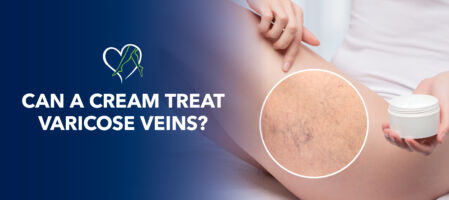
If your varicose veins are causing you pain and discomfort, you have several options, each with a different cost, process, and overall effect. While lotions, cosmetics, creams, and other topical ointments aren’t uncommon as home remedies, their efficiency often comes into question.
The truth is that while topical creams can temporarily improve the symptoms of varicose veins and spider veins, they don’t work as effective, long-term solutions. These alternative therapies are usually available online and don’t require a prescription. But because they don’t address chronic venous insufficiency, the underlying condition responsible for the symptoms they treat, you’ll undoubtedly be left with feelings of aching, throbbing, itching, and heavy legs shortly after applying them.
Fortunately, the board-certified experts at Center for Vein Restoration (CVR) can provide the advanced-level relief you desire, minimizing your need to turn to unreliable home remedies altogether. Read on as we discuss some ingredients used in topical varicose vein ointments for temporary, symptomatic comfort, ways to achieve relief through self-care and where to explore professional, long-lasting treatment.

According to the Cleveland Clinic, one-third of adults have varicose veins, with women at a higher risk than men. While every person has a different medical history, and many have varying goals when exploring treatment, several ingredients found in select topical creams and ointments may yield positive results—albeit temporary—in terms of physical and cosmetic improvements.
Remember, these ingredients and products can be used by anyone looking for temporary relief from vein disease symptoms. Be sure to read ingredient lists carefully and start with small applications to prevent an adverse or allergic reaction.
Arnica is an herb used in homeopathic treatments, often for its anti-inflammatory benefits. According to the Cleveland Clinic, studies have compared its anti-inflammatory effectiveness in the treatment of hand osteoarthritis to topical NSAIDs.
More research is needed to understand arnica’s complex set of medical effects. A 2006 study on people who underwent plastic surgery for wrinkle reduction found that homeopathic arnica boosted healing by reducing swelling, bruising, and pain. Meanwhile, an Annals of Pharmacotherapy study found that the substance actually worsened leg pain 24 hours after a calf exercise routine, according to Healthline.
That said, many have experimented with arnica cream with hopes of temporarily minimizing bruising and swelling caused by varicose veins, giving users a feel for the long-lasting benefits they’ll achieve through a simple and minimally invasive professional vascular treatment.
According to The Standard, hirudoid creams are another common recommendation for those looking to relieve symptoms of varicose veins at home. These products contain heparinoid, an ingredient that can lower inflammation, reduce pain, and boost blood circulation. However, it also fails to address the core issue of vein disease, so it will only offer short-term relief of symptoms.
It’s impossible to say which exact ointment, cream, or ingredient works “best” for varicose vein relief. Again, each person has a radically different medical background, tolerance to certain substances, and purpose for treatment. While we’ve only broken down two of the several topical ingredients that have been used for temporary relief of varicose vein symptoms, each one has something in common: they don’t provide a long-term solution. Relief lasts for a mere moment.
The same is true for creams and ointments for spider veins, which are similar to varicose veins but closer to the surface of the skin. So…what’s the real solution to treating varicose veins at home? Is there truly an effective solution at all? Let’s dig deeper.
Effectively treating varicose veins—whether at home or through a professional procedure—requires targeting the underlying issue of vein disease. Varicose veins and spider veins form when valves in blood vessel walls, typically in the legs, weaken and can no longer efficiently pump blood upward and back toward the heart. The result is painful, itching, throbbing symptoms.
This is precisely why ointments and creams alone don’t provide treatment effective enough to ward off these symptoms for a long period of time—they can’t fully reach the damaged blood vessels due to their topical application.
Effective home treatments will have a direct impact on blood circulation, which will improve symptoms naturally. Suggestions include:
While there are certain temporary benefits that come with using ointments and creams to relieve symptoms of varicose veins and spider veins, long-term, effective treatment for venous disease can only be achieved through professional procedures. Fortunately, CVR’s board-certified physicians are committed to providing vein treatment options that are best tailored to each patient’s needs.
One more consideration—leaving vein disease untreated entirely doesn’t come without its own set of risks. Symptoms often worsen with time, and new ones can emerge, increasing the risk of complications. Advanced vein disease can lead to venous ulcers, which require the removal of dead tissue and have serious infection risks. Staying on top of your vein health comes with an improved quality of life, no matter which stage you’re at.
Have you experimented with varicose vein creams or topical treatments for vein disease without success? It’s not your fault!
Achieve the relief you deserve at long last with one of CVR’s state-of-the-art vein treatment solutions. As the leading physician-led vein care network in the nation with more than 110 locations across 22 states, CVR offers easily accessible, comprehensive, and effective treatment for venous disease.
Call 240-965-3915 or click here to book your consultation immediately with a board-certified CVR vein expert.
CVR accepts many insurances, including Aetna, Amerigroup, Anthem, Blue Cross/Blue Shield, Cigna, MultiPlan, Medicaid, Medicare, and more.